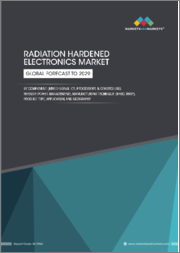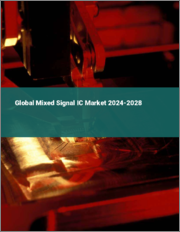
|
시장보고서
상품코드
1468492
믹스드 시그널 IC 시장 보고서 : 유형별, 최종 용도별, 지역별(2024-2032년)Mixed Signal IC Market Report by Type (Mixed Signal SoC, Microcontroller, Data Converter), End Use (Consumer Electronics, Medical and Healthcare, Telecommunication, Automotive, Military and Defense), and Region 2024-2032 |
||||||
세계 믹스드 시그널 IC 시장 규모는 2023년 1,219억 달러에 달했습니다. 향후 IMARC Group은 2032년에는 1,840억 달러에 달할 것으로 예상하며, 2024-2032년 연평균 성장률(CAGR)은 4.6%에 달할 것으로 예측했습니다.
믹스드 시그널 집적회로(IC)는 아날로그 회로와 디지털 회로를 하나의 반도체 다이에 결합하여 디지털 기기의 고도로 통합된 고급 기능을 구현합니다. 아날로그 데이터 스트림을 전자 신호로 변환하는 데이터 컨버터에 의존합니다. 디지털 앰프가 내장된 미디어 및 방송사에서 사용되는 주파수 변조(FM) 튜너에 필수적인 구성요소로 간주됩니다. 현재 디지털 라디오 칩, 신호 변환기, 델타-시그마 변조 변환기, 오류 감지 및 수정 칩은 전 세계적으로 일반적으로 사용되는 믹스드 시그널 IC의 일부입니다.
믹스드 시그널 IC 시장 동향:
일반 휴대폰보다 고급 기능과 인터넷 연결이 가능한 스마트폰에 대한 수요가 증가하고 있는 것이 시장 성장을 촉진하는 주요 요인 중 하나입니다. 또한, 급속한 도시화와 개인 가처분 소득 증가로 인해 고속, 소형 가전제품의 판매가 증가하고 있는 것도 시장 성장에 기여하고 있습니다. 이 외에도 믹스드 시그널 IC는 공조 제어, 에어백 전개, 엔터테인먼트 시스템과 같은 기본 기능의 메커니즘을 제공하기 위해 자동차에 활용되고 있습니다. 이는 각국 정부의 엄격한 자동차 효율 정책 시행으로 인한 대체 연료 차량에 대한 수요 증가와 함께 시장에 긍정적인 영향을 미치고 있습니다. 이와는 별도로, 믹스드 시그널 IC는 환자의 진단, 치료, 관리 및 모니터링에 필수적인 최신 임베디드 의료기기 및 영상 진단 시스템에 광범위하게 적용되어 의료 산업에서 중요한 역할을 하고 있습니다. 또한, 만성질환의 확산에 따른 진단 도구와 기술에 대한 수요가 증가하면서 전 세계적으로 믹스드 시그널 IC의 채택을 촉진하고 있습니다. 또한, 혁신적인 믹스드 시그널 IC의 개발로 인해 산업 분야에서 필수적인 도구로 전 세계적으로 사용이 확대될 것으로 예상됩니다.
본 보고서에서 다루는 주요 질문들
- 2023년 세계 믹스드 시그널 IC 시장 규모는?
- 2024-2032년 믹스드 시그널 IC 세계 시장 예상 성장률은?
- 믹스드 시그널 IC 세계 시장을 주도하는 주요 요인은 무엇인가?
- COVID-19가 세계 믹스드 시그널 IC 시장에 미치는 영향은?
- 믹스드 시그널 IC 세계 시장 유형별 분류는?
- 믹스드 시그널 IC 세계 시장에서의 최종 용도별 분류는?
- 믹스드 시그널 IC 세계 시장에서 주요 지역은?
- 믹스드 시그널 IC 세계 시장 주요 진출 기업은?
목차
제1장 서문
제2장 조사 범위와 조사 방법
- 조사 목적
- 이해관계자
- 데이터 소스
- 1차 정보
- 2차 정보
- 시장 추정
- 상향식 접근
- 하향식 접근
- 조사 방법
제3장 주요 요약
제4장 소개
- 개요
- 주요 산업 동향
제5장 믹스드 시그널 IC 세계 시장
- 시장 개요
- 시장 실적
- COVID-19의 영향
- 시장 예측
제6장 시장 내역 : 유형별
- 믹스드 시그널 SoC
- 시장 동향
- 시장 전망
- 마이크로컴퓨터
- 데이터 컨버터
제7장 시장 내역 : 최종 용도별
- 가전제품
- 의료 의료
- 통신
- 자동차
- 군·방위
제8장 시장 내역 : 지역별
- 북미
- 미국
- 캐나다
- 아시아태평양
- 중국
- 일본
- 인도
- 한국
- 호주
- 인도네시아
- 기타
- 유럽
- 독일
- 프랑스
- 영국
- 이탈리아
- 스페인
- 러시아
- 기타
- 라틴아메리카
- 브라질
- 멕시코
- 기타
- 중동 및 아프리카
- 시장 동향
- 시장 내역 : 국가별
- 시장 예측
제9장 SWOT 분석
- 개요
- 강점
- 약점
- 기회
- 위협
제10장 밸류체인 분석
제11장 Porter's Five Forces 분석
- 개요
- 구매자의 교섭력
- 공급 기업의 교섭력
- 경쟁 정도
- 신규 참여업체의 위협
- 대체품의 위협
제12장 가격 분석
제13장 경쟁 상황
- 시장 구조
- 주요 기업
- 주요 기업 개요
- Analog Devices Inc.
- Cirrus Logic Inc.
- Dialog Semiconductor PLC(Renesas Electronics Corporation)
- EnSilica Limited
- Infineon Technologies AG
- Intel Corporation
- Microchip Technology Inc.
- National Instruments Corporation
- Renesas Electronics Corporation
- STMicroelectronics
- Telephonics Corporation(Griffon Corporation)
- Texas Instruments Incorporated
The global mixed signal IC market size reached US$ 121.9 Billion in 2023. Looking forward, IMARC Group expects the market to reach US$ 184.0 Billion by 2032, exhibiting a growth rate (CAGR) of 4.6% during 2024-2032.
Mixed-signal integrated circuits (ICs) combine analog and digital circuitry on a single semiconductor die for the highly integrated, sophisticated functionality of digital devices. It relies on data converters to translate analog data streams into electronic signals. It is considered a vital component in frequency modulation (FM) tuners that are used in media players with built-in digital amplifiers. At present, digital radio chips, signal converters, delta-sigma modulation converters, and error detection and correction chips are some of the commonly available mixed-signal ICs around the world.
Mixed Signal IC Market Trends:
The escalating demand for smartphones with more advanced capabilities and internet connectivity than regular mobile phones represents one of the major factors impelling the market growth. Moreover, boosting sales of fast and miniature consumer electronics on account of rapid urbanization and inflating disposable income of individuals are contributing to the market growth. Besides this, mixed-signal ICs are utilized in cars for providing the mechanism for basic functions, such as climate control, airbag deployment, and entertainment systems. This, in confluence with the increasing need for alternative fuel vehicles due to the implementation of stringent policies by governments of numerous countries regarding vehicle efficiency, is influencing the market positively. Apart from this, mixed-signal ICs play a significant role in the healthcare industry as they find extensive applications in modern implantable medical devices and imaging systems that are essential for the diagnosis, treatment, management, and monitoring of patients. Additionally, the rising demand for diagnostic tools and techniques on account of the growing prevalence of chronic diseases is driving the adoption of mixed-signal ICs across the globe. Furthermore, the development of innovative mixed-signal ICs is projected to expand their utilization as essential tools in industrial fields worldwide.
Key Market Segmentation:
IMARC Group provides an analysis of the key trends in each sub-segment of the global mixed signal IC market report, along with forecasts at the global, regional and country level from 2024-2032. Our report has categorized the market based on type and end use.
Breakup by Type:
Mixed Signal SoC
Microcontroller
Data Converter
Breakup by End Use:
Consumer Electronics
Medical and Healthcare
Telecommunication
Automotive
Military and Defense
Breakup by Region:
North America
United States
Canada
Asia-Pacific
China
Japan
India
South Korea
Australia
Indonesia
Others
Europe
Germany
France
United Kingdom
Italy
Spain
Russia
Others
Latin America
Brazil
Mexico
Others
Middle East and Africa
Competitive Landscape:
The competitive landscape of the industry has also been examined along with the profiles of the key players being Analog Devices Inc., Cirrus Logic Inc., Dialog Semiconductor PLC (Renesas Electronics Corporation), EnSilica Limited, Infineon Technologies AG, Intel Corporation, Microchip Technology Inc., National Instruments Corporation, Renesas Electronics Corporation, STMicroelectronics, Telephonics Corporation (Griffon Corporation) and Texas Instruments Incorporated.
Key Questions Answered in This Report
- 1. What was the size of the global mixed signal IC market in 2023?
- 2. What is the expected growth rate of the global mixed signal IC market during 2024-2032?
- 3. What are the key factors driving the global mixed signal IC market?
- 4. What has been the impact of COVID-19 on the global mixed signal IC market?
- 5. What is the breakup of the global mixed signal IC market based on the type?
- 6. What is the breakup of the global mixed signal IC market based on the end use?
- 7. What are the key regions in the global mixed signal IC market?
- 8. Who are the key players/companies in the global mixed signal IC market?
Table of Contents
1 Preface
2 Scope and Methodology
- 2.1 Objectives of the Study
- 2.2 Stakeholders
- 2.3 Data Sources
- 2.3.1 Primary Sources
- 2.3.2 Secondary Sources
- 2.4 Market Estimation
- 2.4.1 Bottom-Up Approach
- 2.4.2 Top-Down Approach
- 2.5 Forecasting Methodology
3 Executive Summary
4 Introduction
- 4.1 Overview
- 4.2 Key Industry Trends
5 Global Mixed Signal IC Market
- 5.1 Market Overview
- 5.2 Market Performance
- 5.3 Impact of COVID-19
- 5.4 Market Forecast
6 Market Breakup by Type
- 6.1 Mixed Signal SoC
- 6.1.1 Market Trends
- 6.1.2 Market Forecast
- 6.2 Microcontroller
- 6.2.1 Market Trends
- 6.2.2 Market Forecast
- 6.3 Data Converter
- 6.3.1 Market Trends
- 6.3.2 Market Forecast
7 Market Breakup by End Use
- 7.1 Consumer Electronics
- 7.1.1 Market Trends
- 7.1.2 Market Forecast
- 7.2 Medical and Healthcare
- 7.2.1 Market Trends
- 7.2.2 Market Forecast
- 7.3 Telecommunication
- 7.3.1 Market Trends
- 7.3.2 Market Forecast
- 7.4 Automotive
- 7.4.1 Market Trends
- 7.4.2 Market Forecast
- 7.5 Military and Defense
- 7.5.1 Market Trends
- 7.5.2 Market Forecast
8 Market Breakup by Region
- 8.1 North America
- 8.1.1 United States
- 8.1.1.1 Market Trends
- 8.1.1.2 Market Forecast
- 8.1.2 Canada
- 8.1.2.1 Market Trends
- 8.1.2.2 Market Forecast
- 8.1.1 United States
- 8.2 Asia-Pacific
- 8.2.1 China
- 8.2.1.1 Market Trends
- 8.2.1.2 Market Forecast
- 8.2.2 Japan
- 8.2.2.1 Market Trends
- 8.2.2.2 Market Forecast
- 8.2.3 India
- 8.2.3.1 Market Trends
- 8.2.3.2 Market Forecast
- 8.2.4 South Korea
- 8.2.4.1 Market Trends
- 8.2.4.2 Market Forecast
- 8.2.5 Australia
- 8.2.5.1 Market Trends
- 8.2.5.2 Market Forecast
- 8.2.6 Indonesia
- 8.2.6.1 Market Trends
- 8.2.6.2 Market Forecast
- 8.2.7 Others
- 8.2.7.1 Market Trends
- 8.2.7.2 Market Forecast
- 8.2.1 China
- 8.3 Europe
- 8.3.1 Germany
- 8.3.1.1 Market Trends
- 8.3.1.2 Market Forecast
- 8.3.2 France
- 8.3.2.1 Market Trends
- 8.3.2.2 Market Forecast
- 8.3.3 United Kingdom
- 8.3.3.1 Market Trends
- 8.3.3.2 Market Forecast
- 8.3.4 Italy
- 8.3.4.1 Market Trends
- 8.3.4.2 Market Forecast
- 8.3.5 Spain
- 8.3.5.1 Market Trends
- 8.3.5.2 Market Forecast
- 8.3.6 Russia
- 8.3.6.1 Market Trends
- 8.3.6.2 Market Forecast
- 8.3.7 Others
- 8.3.7.1 Market Trends
- 8.3.7.2 Market Forecast
- 8.3.1 Germany
- 8.4 Latin America
- 8.4.1 Brazil
- 8.4.1.1 Market Trends
- 8.4.1.2 Market Forecast
- 8.4.2 Mexico
- 8.4.2.1 Market Trends
- 8.4.2.2 Market Forecast
- 8.4.3 Others
- 8.4.3.1 Market Trends
- 8.4.3.2 Market Forecast
- 8.4.1 Brazil
- 8.5 Middle East and Africa
- 8.5.1 Market Trends
- 8.5.2 Market Breakup by Country
- 8.5.3 Market Forecast
9 SWOT Analysis
- 9.1 Overview
- 9.2 Strengths
- 9.3 Weaknesses
- 9.4 Opportunities
- 9.5 Threats
10 Value Chain Analysis
11 Porters Five Forces Analysis
- 11.1 Overview
- 11.2 Bargaining Power of Buyers
- 11.3 Bargaining Power of Suppliers
- 11.4 Degree of Competition
- 11.5 Threat of New Entrants
- 11.6 Threat of Substitutes
12 Price Analysis
13 Competitive Landscape
- 13.1 Market Structure
- 13.2 Key Players
- 13.3 Profiles of Key Players
- 13.3.1 Analog Devices Inc.
- 13.3.1.1 Company Overview
- 13.3.1.2 Product Portfolio
- 13.3.1.3 Financials
- 13.3.1.4 SWOT Analysis
- 13.3.2 Cirrus Logic Inc.
- 13.3.2.1 Company Overview
- 13.3.2.2 Product Portfolio
- 13.3.2.3 Financials
- 13.3.2.4 SWOT Analysis
- 13.3.3 Dialog Semiconductor PLC (Renesas Electronics Corporation)
- 13.3.3.1 Company Overview
- 13.3.3.2 Product Portfolio
- 13.3.3.3 Financials
- 13.3.4 EnSilica Limited
- 13.3.4.1 Company Overview
- 13.3.4.2 Product Portfolio
- 13.3.5 Infineon Technologies AG
- 13.3.5.1 Company Overview
- 13.3.5.2 Product Portfolio
- 13.3.5.3 Financials
- 13.3.5.4 SWOT Analysis
- 13.3.6 Intel Corporation
- 13.3.6.1 Company Overview
- 13.3.6.2 Product Portfolio
- 13.3.6.3 Financials
- 13.3.6.4 SWOT Analysis
- 13.3.7 Microchip Technology Inc.
- 13.3.7.1 Company Overview
- 13.3.7.2 Product Portfolio
- 13.3.7.3 Financials
- 13.3.7.4 SWOT Analysis
- 13.3.8 National Instruments Corporation
- 13.3.8.1 Company Overview
- 13.3.8.2 Product Portfolio
- 13.3.8.3 Financials
- 13.3.8.4 SWOT Analysis
- 13.3.9 Renesas Electronics Corporation
- 13.3.9.1 Company Overview
- 13.3.9.2 Product Portfolio
- 13.3.9.3 Financials
- 13.3.9.4 SWOT Analysis
- 13.3.10 STMicroelectronics
- 13.3.10.1 Company Overview
- 13.3.10.2 Product Portfolio
- 13.3.10.3 Financials
- 13.3.10.4 SWOT Analysis
- 13.3.11 Telephonics Corporation (Griffon Corporation)
- 13.3.11.1 Company Overview
- 13.3.11.2 Product Portfolio
- 13.3.12 Texas Instruments Incorporated
- 13.3.12.1 Company Overview
- 13.3.12.2 Product Portfolio
- 13.3.12.3 Financials
- 13.3.12.4 SWOT Analysis
- 13.3.1 Analog Devices Inc.












